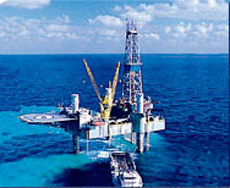Specialty Drilling Fluid Additives
Setac Established the Benchmark for Balanced Alkalinity
We’ve been manufacturing drilling fluid additives and touting maximum performance coupled with environmental safety for almost forty years.
It was Setac who established the Balanced Alkalinity concept in the Gulf of Mexico with the assistance of some highly qualified engineers and an operator who recognized the importance. It was a good system then, and it’s a better system now. The current emphasis placed on environmental safety and high drilling cost make this system more attractive than ever before.

The whole idea about drilling an oil and gas well is to extract the maximum amount of product for the least amount of cost. The gulf coast is fraught with problems, and water-based systems lost favor to synthetics. These problems include:
1. Gumbo Shale
2. Loss of Circulation
3. Elevated Bottom Hole Temperatures
4. Heaving Shale and Unconsolidated Sand
Image credit Dimitri Otis/Getty Images
Envirodrill™-Balanced Alkalinity Mud System
Oil base drilling fluids work exceptionally well with these conditions, but environmental safety, even with synthetic oil, suffers accordingly.
Moreover, the cost of cuttings disposal has become excessive. Synthetic oil systems still have a place, but they do not have to be the system of choice and probably shouldn’t be.
Normally, water base fluids do not address these desired requirements
1. Environmental Safety with Offshore Discharge
2. Fast Penetration Rates
3. Pipe Sticking Prevention
4. Elevated temperature tolerance
5. Hole Cleaning and Integrity Guarantees 6. Reservoir Performance Improvement
Balanced Alkalinity and New Technology Breathes New Life to a Unique Water-Base System
There is a multitude of new water-based systems on today’s market. Inorganic chemistry, silicates, high molecular weight polymers, and the list is endless. But, operators are starting to discover reservoir impairment with exotic systems.
In some cases, they are plugging and abandoning expensive holes where hydrocarbons are present. Improvements to the fracking procedure have helped, but reservoir impairment still occurs. The realization that simplicity with improvements to an old tried and true system may be the answer is worth evaluating.
There is an alternative:
Envirodrill™ coupled with an innovative concept, and a new line of products to enhance the system exceeds the requirements.
Simplicity
Certain specialty products can destroy a carefully planned budget and severely damage a reservoir. Exotic formulations and high molecular weight polymers are NOT required and Diesel or Synthetic oil is NOT needed.
However, surfactant chemistry is required, but it needs tailoring for the requirement. A triglyceride ester was found to enhance the primary system several years ago and continues to play a part.
Balance
What does Balance do for me?
Balance is not a new concept. All systems require balance to a certain extent, but balance becomes critical when divalent ion chemistry is used for inhibition. Setac recognized the concept years ago and realized that balancing the alkalinity allowed thinners, filtrate loss control agents and even loss circulation materials to perform dramatically better than when the system is not balanced. Balance is the key to a successful well without the use of exotic chemistry.
What is Balanced Alkalinity?
Balance occurs when the soluble calcium will not decrease any further with additions of caustic soda or KOH. The best rule of thumb for treatment is to add one sack of caustic with every 2 sacks of lime. A method for determining balance is to insure the excess lime value is nearly equal to the pF alkalinity. The p mud and p filtrate alkalinity values are not exact numbers, but a trend can be developed for accuracy. The p mud and p filtrate alkalinity is far more accurate than pH in lime mud. The ideal p mud alkalinity is 6-10 and the ideal p filtrate alkalinity is 1.5-2.5. The pH of lime base mud is above 11.5. Sticky and swelling shale is not caused by elevated pH as sometimes reported. Clay particle instability is caused by sodium base exchange. Calcium is the dominant ion and as long as the system is "Balanced", the system will remain stable.
Envirodrill™
This unique system incorporates old technology with innovative techniques that exceed the capability of all other water-based drilling fluids and approaches oil base mud performance. Maximum performance and complete environmental safety mean you can drill fast with no hole problems and dump the cuttings offshore and do it cheaper by using seawater as your base.

1. Divalent ion inhibition
2. Clay particle encapsulation
3. Surfactant chemistry (wetter and slipperier water)
4. And Balanced Alkalinity
New and Improved Products complete the package
Products
Boremaster™
We modified a previous successful shale control product to provide better shielding, added a lubricity agent and designed it to provide vast improvement to the HT/HPfiltrate loss in a divalent ion fluid.
XP-911™
A seepage loss material that works in all fluids without changing the viscosity
Drillfast™
A triglyceride ester for lubricity and penetration rate
Liquid HEC
Inhibited fluids using seawater have difficulty maintaining viscosity. Prehydrated Bentonite with small additions of liquid HEC provides excellent viscosity control in the Envirodrill system. Thermal tolerance up to 300º F is achieved with an oxygen scavenger such as sodium sulfite. Moreover, HEC will not harm producing reservoirs and is a better alternative to xanthan gum.
The Balanced Alkalinity concept has been used successfully on and offshore for several years.
Experience
|
|
|
|

